- Blog
Best Ergonomic Keyboards 2025: Split, Wave & Alice Picks for Work & Coding

Table of Contents
ToggleTyping comfort isn’t a luxury—it’s daily productivity. This guide explains the main ergonomic layouts (split, wave, Alice, ortholinear), what to look for (tenting, tilt, wrist support, connectivity), and then lists the most popular, globally recognized ergonomic keyboards with quick-scan specs, prices, and user feedback.
What “ergonomic” really means (and why it matters)
-
Split layout: Left/right halves separate so you can match shoulder width and reduce ulnar deviation. Many models add tenting (5°–15°+) to keep forearms neutral.
-
Wave/curved deck: Keys follow a gentle arc; the center dips to keep wrists straighter. Typically includes a plush wrist rest for relaxed posture.
-
Thumb clusters: Extra keys near the thumbs for modifiers/macros to reduce pinky strain.
-
Wrist support: Built-in palm rest (often memory foam or padded) reduces pressure points during long sessions.
-
Adjustable angles: Negative tilt (front higher than back) or multi-stage feet let you fine-tune wrist angle.
-
Key matrix: Standard staggered rows (familiar) vs columnar/ortholinear (each finger moves straight up/down). Columnar has a learning curve but excellent long-term ergonomics.
-
Connectivity & software: 2.4 GHz + Bluetooth multi-device is ideal for hybrid workflows; QMK/VIA or brand software enables deep remaps and app-specific shortcuts.
Buying checklist (quick)
-
Hand size & posture (palm vs claw; shoulder width for split boards)
-
Layout learning curve tolerance (wave < Alice < split columnar)
-
Desk depth & numpad needs (full size vs TKL/65%)
-
Connectivity (Bluetooth/2.4 GHz/wired) & OS support
-
Wrist rest quality and tenting options
-
Hot-swap switches if you like to tune sound/feel
Top Ergonomic Keyboard Picks (Global)
Format per item: Brand/Model, Price, Product Highlights, User Feedback
1) Logitech ERGO K860
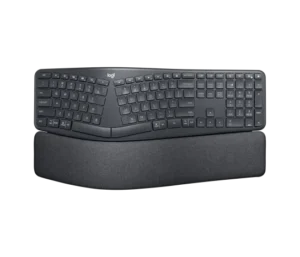
Price: ~US$120–$150
Product highlights: Full-size wave/curved split-style deck, integrated memory-foam palm rest, adjustable tilt (including slight negative tilt), Bluetooth or Logi Bolt wireless, multi-device pairing.
User feedback: Consistently praised for all-day comfort and quiet typing. Minimal learning curve vs full split boards. Trade-offs: no backlight; non-mechanical dome feel.
2) Logitech Wave Keys
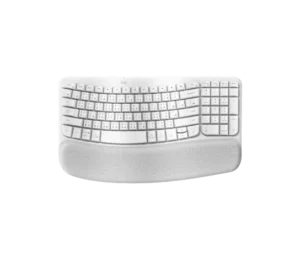
Price: ~US$70
Product highlights: Compact wave design with thick memory-foam wrist rest, Bluetooth/Logi Bolt with easy device switching, quiet office-friendly key feel.
User feedback: Loved for silence, comfort and price. Heavier keystroke than mechanical; no backlight; palm rest is fixed (non-removable).
3) Microsoft Sculpt Ergonomic Keyboard (combo)

Price: ~US$80–$100
Product highlights: Iconic arched split layout with large cushioned wrist rest; includes separate numpad; 2.4 GHz USB receiver.
User feedback: A proven “pain-reducer” for many office users; sturdy and familiar. Deeper key travel and a modest learning curve; not aimed at gaming.
4) Kinesis Freestyle2 (USB or Bluetooth)

Price: ~US$99 (+ optional kits)
Product highlights: True split halves connected by a flexible cable (choose length). Optional VIP kits add 5°/10°/15° tenting and palm supports. Office hotkeys baked in; quiet low-force keys.
User feedback: Exceptional adjustability and ergonomics. Downsides: add-on kits increase total cost; membrane feel not for mechanical fans.
5) Matias Ergo Pro (mechanical, split TKL)
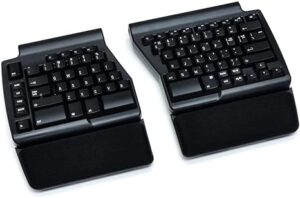
Price: ~US$200
Product highlights: Split mechanical with three tilt options (includes negative tilt), detachable palm rests, quiet tactile Matias switches, Mac/Win variants.
User feedback: Crisp tactile feel and posture-friendly angles; simple, driver-free. No backlight; more “utilitarian” fit & finish for the price.
6) ZSA Moonlander (split, columnar/ortholinear)
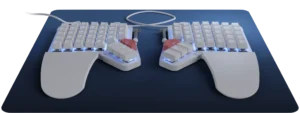
Price: ~US$365+
Product highlights: Fully split, columnar layout with adjustable thumb-clusters, hot-swap switches, per-key RGB, tenting accessories, powerful online configurator (QMK-based).
User feedback: Ergonomics and programmability are industry-leading. Steeper learning curve; premium price; wired-only by design.
7) Keychron Q8 Max (Alice layout, 65%)
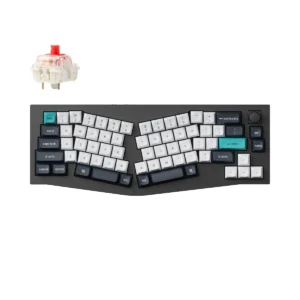
Price: ~US$150–$200
Product highlights: Alice-style split-arc layout in an all-metal chassis, gasket mount, hot-swap, QMK/VIA, wired + Bluetooth multi-device.
User feedback: Excellent build and comfort once acclimated. No included wrist rest; higher weight (solid aluminum) for portability.
8) Kensington Pro Fit Ergo Wireless Keyboard
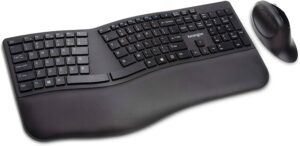
Price: ~US$60–$80
Product highlights: Budget-friendly curved/split-inspired layout, negative tilt option, integrated palm rest, 2.4 GHz wireless via USB receiver.
User feedback: Great value for improving posture on a budget. Bigger footprint and basic build; limited software customization.
9) Dygma Defy (wireless, split, columnar)
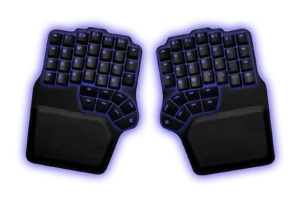
Price: from ~US$369 (bundles higher)
Product highlights: Premium wireless split with columnar matrix, 0–60° tenting plus reverse tilt, large thumb clusters, hot-swap switches, per-key RGB, 2.4 GHz/Bluetooth/wired.
User feedback: “Endgame” ergonomics and macros for power users, devs and gamers. Pricey and physically larger; setup takes time.
Bonus mention: Kinesis Advantage-class contoured boards

Price: ~US$279+
Product highlights: Deeply contoured key wells with large thumb clusters; minimizes finger travel and pinky load.
User feedback: Legendary comfort after the learning curve; very specialized form factor.
Which one should you pick?
-
Fastest to adapt (office): Logitech Wave Keys or ERGO K860
-
Maximum adjustability (office/coding): Kinesis Freestyle2 (+ tenting/palm kits)
-
Mechanical + split without software fuss: Matias Ergo Pro
-
Alice comfort + premium build: Keychron Q8 Max
-
Ultimate programmability (dev/power-user): ZSA Moonlander or Dygma Defy
-
Best budget starter: Kensington Pro Fit Ergo Wireless
-
Chronic wrist strain, ready to relearn layout: Kinesis Advantage-class
FAQ
Q1: Split vs wave—what’s better?
Split gives you shoulder-width alignment and tenting for neutral forearms—best long-term if you can handle the learning curve. Wave is easier to adopt, with a gentler curve and built-in wrist rest.
Q2: Are Alice keyboards ergonomic?
Yes. Alice staggers the halves with a soft arc, reducing wrist twist while keeping a familiar row layout—great middle ground between wave and full split.
Q3: Do I need tenting?
If you type many hours daily, 5°–15° tenting noticeably relaxes forearms. It’s most effective on split boards (e.g., Freestyle2, Moonlander, Defy).
Q4: Mechanical or membrane for ergonomics?
Both can be ergonomic. Mechanical offers lighter, more consistent actuation and longevity; membrane can be quieter and cheaper. Comfort = angle + posture + wrist support.
Q5: Will an ergonomic keyboard fix wrist pain?
It can help—especially paired with proper chair height, desk depth, and negative tilt—but consult a professional for persistent pain.





